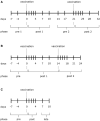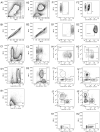Development of an advanced flow cytometry based high-resolution immunophenotyping method to benchmark early immune response in dairy cows
- PMID: 34819614
- PMCID: PMC8613216
- DOI: 10.1038/s41598-021-02405-w
Development of an advanced flow cytometry based high-resolution immunophenotyping method to benchmark early immune response in dairy cows
Abstract
The determination of the somatic cell count of a milk sample is one of the most common methods to monitor udder health of a dairy cow. However, this procedure does not take into account the fact that cells in milk present a great variety of different cell types. The objective of our study was to establish a high-resolution differential cell count (HRDCC) by means of flow cytometry in blood and milk. We were able to detect ten subpopulations among the three main populations of immune cells and to determine their viability. Additionally, blood samples were analyzed for common laboratory biomarkers, i.e. differential blood counts, haptoglobin levels and several metabolic parameters. In this first feasibility study, we used three different vaccines to stimulate the immune system of five healthy cows each. Samples were collected shortly before, in between and after the vaccinations. Using multivariate statistical methods we saw a diagnostic benefit when HRDCCs were included compared to only the standard laboratory parameters. The impacts of all three vaccinations on the immune system were visible in blood HRDCCs as well as in milk HRDCCs. Cluster of Differentiation 8+ (CD8+) T cells, B cells and monocyte/macrophage subpopulations were among the most important and statistically relevant parameters for all treatments in both biofluids. Moreover, in one of the treatment groups intermediate monocytes showed a significant increase after both vaccinations. Although the use of HRDCC in blood or milk was shown to be highly relevant for early systemic diagnostic, to confirm these subpopulations further investigations in cows of different breed, lactation stage or health status are required.
© 2021. The Author(s).
Conflict of interest statement
The authors declare no competing interests.
Figures








References
Publication types
MeSH terms
Substances
LinkOut - more resources
Full Text Sources
Research Materials

